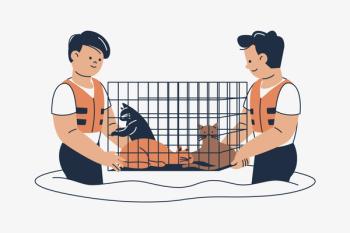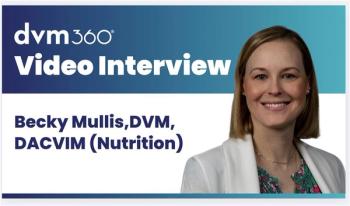
5 things you need to know about food aggression
Use these tips to help comfort concerned clients worries about their pet during mealtime.
shutterstock.com
While behavioral consultations are not the strong suit of most general practitioners, there is still basic advice you can and should give your clients regarding food-bowl aggression. Dr. Julia Albright, DVM, MA, DACVB, and
1. Let sleeping dogs lie, and eating dogs eat
Avoidance is a good idea regardless of the family's choice for structured behavior modification or not, Dr. Albright says. In some situations, the family may find avoidance the best policy (feeding behind a physical barrier and not messing with the dog during mealtime). If there are children involved, feed the dog behind a closed door to avoid incident. The clients may feel this is all that is needed to keep everyone safe and happy. Aside from some exceptions with a new dog or puppy that may need to learn that food is not a scarce resource, never free feed a dog with food-bowl aggression. If the food is there all the time, then the dog may feel the need to continually guard the resource, says Dr. Albright.
Jog your memory
The two types of learning are:
Operant-that is both the reward-based and the traditional, aversive correction type; any time an animal voluntarily chooses to perform a behavior based on past consequences)
Classical/Pavlovian-involuntary pairing of something in the world with a physiologic response. That is an emotional connection.
2. Emotion drives behavior
As Sophia Yin, DVM, showed us, reward-based training is a very effective and humane way to change most any behavior. However, we shouldn't forget a dog's underlying emotional state also motivates her to act a certain way. Ivan Pavlov (does that ring a bell?) is famous for recognizing the type of involuntary learning (also known as classical conditioning) that causes an association between a person, place, or thing and an inner state. A seemingly neutral stimulus can therefore trigger strong emotional response. For example, a dog with separation anxiety sees you get your keys and starts whining because keys = you leave. The dog doesn't decide to whine, it is an involuntary reaction learned through repetition, like Pavlov's dogs that salivated when he rang the bell. On the other hand, reward-based training, or operant conditioning, is learning behavior through consequences-either praise or punishment. In this example, trying to decrease the whining through aversive correction increases the distress the dog feels about his family departing, making the separation anxiety worse in the long run.
Likewise, food-bowl aggression can also be addressed using classical conditioning principles. Think about the underlying emotion for food bowl aggression: people approaching the bowl = possible loss of food. Dr. Albright says, especially in the early stages of the disorder, if your client reports that the dog stiffens, eats faster when you approach the food bowl (an early sign of resource guarding), or even growls she recommends advising the client to start tossing a highly palatable treat in the bowl every time they approach the dog at the food bowl, preferably before the dog gets upset and from a safe distance. That way, the dog builds a positive association between the human near the food bowl and a tasty treat, and over time, the aggressive behavior may be extinguished. Dr. Albright also says this is a good idea to help prevent the problem in non-food aggressive dogs. If there are children in the home, she also recommends involving them in this practice, with the caveat that the children and dog are supervised and precautions (like baby gates or an adult holding the child) are taken to avoid bites. Reward-based training, like asking the dog to sit for the tasty treat when you approach the bowl is a good option for improving that emotional response to someone approaching the bowl.
3. Don't mess with the puppy's bowl
Many trainers and vets have recommended messing with the puppy while he is eating (such as taking the bowl away several times, petting the puppy, etc.) to help desensitize the puppy to these actions from humans. But Dr. Albright advises against this because it could actually condition the puppy to think that people around his food are unpleasant. Repeating an action over and over again doesn't always result in the animal learning to tolerant and action. It could do the opposite of helping the puppy “get over it.” While a dog with a tolerant personality is likely to allow your messing with them while they are eating, in general dogs don't like it, and it isn't a good practice, she says. Clients may inadvertently be creating an aversion to people approaching the bowl if a good reward, like a little treat, isn't also provided. We should be advising clients against poking and proding a dog while eating. It may help to tell clients that messing with a dog's food bowl when he is trying to eat is like somebody messing with your plate or petting your head when you are trying to eat dinner. Nobody likes that. However, you may be more tolerant, maybe even look forward to the person approaching if you know that the person was going to give you a small bowl of Ben & Jerry's Chocolate Therapy ice cream every time they approached.
4. Does competition make it worse?
A
5. Labels are for canned goods
When it comes to labeling the type of aggression, Dr. Albright thinks the label is less important and teaches that to her students. Whether it is territorial, dominance, resource guarding or possessive aggression, the type of aggression present doesn't really matter when using a reward-based approach to treat the problem. What matters is that the dog doesn't like something. He thinks that thing sucks, and our job is to make it not suck. Reducing the suck factor is best accomplished through reward-based training (not always treats-It can also be through affection, toy, distance, etc.).
Dr. Sarah Wooten graduated from UC Davis School of Veterinary Medicine in 2002. A member of the American Society of Veterinary Journalists, Dr. Wooten divides her professional time between small animal practice in Greeley, Colorado, public speaking on associate issues, leadership and client communication, and writing. She enjoys camping with her family, skiing, SCUBA, and participating in triathlons.
Newsletter
From exam room tips to practice management insights, get trusted veterinary news delivered straight to your inbox—subscribe to dvm360.






